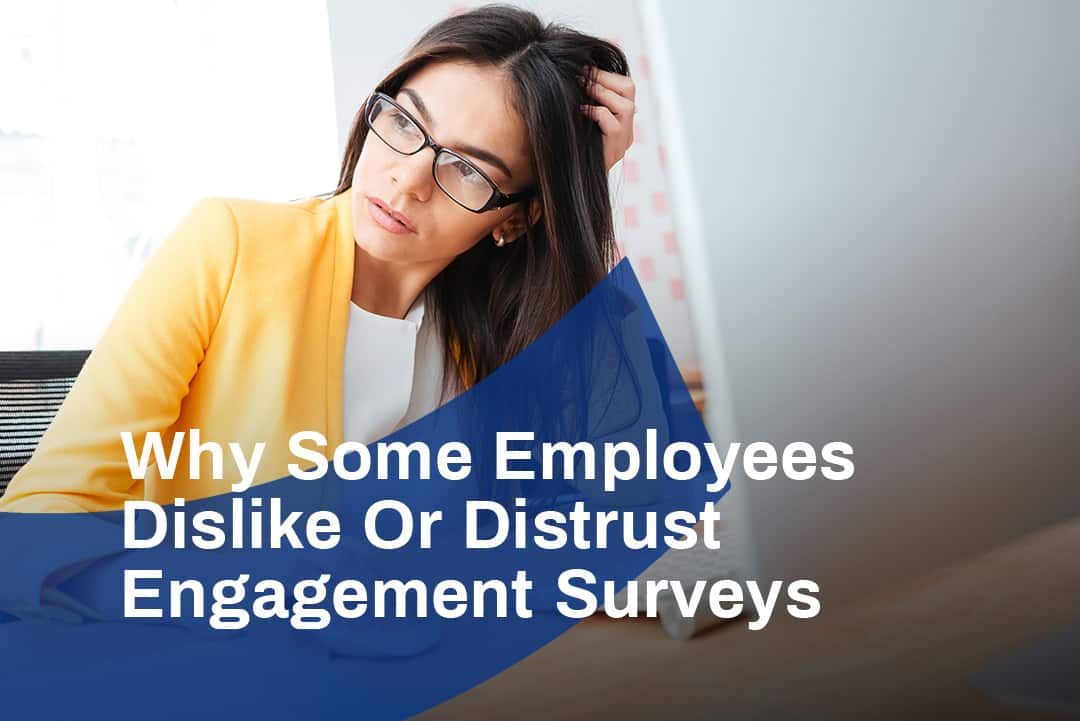Employee surveys are the foundation of any effective engagement strategy. They provide leadership with the information they need to measure employee engagement, formulate action plans, and enact positive change. However, if employees either dislike, distrust, or don’t care about the engagement surveys, managers will always lack the accurate, genuine insights they need to drive that change.
Therefore, organizations need to develop a sense of trust in employee engagement survey questions from their people. We’re going to look at some of the different sources of dislike or distrust in surveys, some best practices HR and leaders can use to remedy any issues, and help you make the most of your engagement surveys and strategy.
When Employees Dislike Engagement Surveys
If your organization and workforce are new to engagement surveys, then any initial dislike of them could simply come from unfamiliarity. New initiatives, no matter what they target, are often met with ambivalence – or even contempt – from an employee base.
However, if your workforce dislikes your engagement survey program, whether it’s a new initiative or an ongoing effort, it’s something you should address as quickly as possible. Otherwise, you’ll never realize the full benefits of improved employee engagement.
From our experience, there are two main sources of dislike for an existing survey program – survey fatigue and inconvenience.
Survey Fatigue
It is possible to have too much of a good thing. When it comes to engagement surveys, a less is more approach will always serve you best, as long as the survey questions are mutually exclusive and collectively exhaustive (MECE). In other words, cover every topic you want employee feedback from but with the fewest number of questions possible. Don’t sacrifice insight for brevity, but keep attention spans and patience levels in mind as you design your employee engagement survey questions.

Likewise, employees will soon fatigue on the process if they are asked to take a 100 question survey every quarter. As we’ve discussed in the past, an effective approach is to start with a larger survey but then follow up with shorter pulse surveys to drill further down into particular issues. This technique allows you to reveal maximum insights without employees growing weary of the survey process.
Inconvenient Method of Delivery
Not only will employees grow to dislike surveys if they’re too long or too frequent, but also if you deliver them in an inconvenient manner. Employees will be more likely to embrace your engagement surveys – and therefore participate in them – when they can take them within their flow of work.

For example, field employees will be far more receptive to mobile-friendly surveys than a format built for a desktop. Make each survey and pulse poll as seamless as possible within your employee segments’ workflow. For many organizations, this means distributing a single survey across multiple platforms. While field employees such as Account Executives or deskless employees will prefer mobile-friendly surveys with capabilities like SMS alerts and reminders, office employees will likely prefer being notified through email or Slack, as they sit at a computer most of the day.
Why Employees Distrust Engagement Surveys
Distrust is possibly more corrosive than dislike when it comes to your engagement strategy. When employees lack trust in the process, they’re less likely to provide authentic and genuine responses. Suffice it to say, engagement surveys rely on accuracy and honesty. Without those traits, your decision-makers cannot trust the reliability of the data. Just like issues stemming from a workforce disliking the survey process, distrust stems from two main sources – anonymity and a lack of action.
Distrust in Anonymous Surveys
We’ve spoken at length on the value of anonymity in an engagement strategy. Anonymous surveys provide an employee with a sense of security and safety, where they don’t feel as if they’re risking their job or career by giving honest answers. One of the most significant issues with anonymous surveys, however, is a workforce questioning if their responses are truly anonymous.
Building Trust in Anonymity
There are a few actions that HR and an employer can take to foster trust in an anonymous survey, giving employees the assurance they need while also driving better engagement. With these three proactive measures, employees will feel more comfortable in the engagement survey process and, therefore, more willing to provide authentic responses.

1. Define Anonymity
It’s difficult for a workforce to trust an anonymous survey if the organization doesn’t give context to the anonymity. Take the time to provide a concise definition of the term, telling employees exactly what anonymity entails – no titles, names, or any other identifiable trait. Employees must have a clear understanding of the ways that anonymity protects them as well as how HR & management will use data like department, tenure, and other information to identify hotspots and patterns.
2. Communicate With employees
It’s always beneficial when the upper levels of an organization communicate with employees. When someone from the C-suite ranks, for instance, sends an email to the workforce explaining the importance of engagement surveys and how anonymity protects them, they’re much more likely to take the message to heart once they sit down to take a survey.
Further, it’s important to “socialize” the surveys, pushing communication beyond a mere email from an executive and bringing it to the team or department level. Managers can have meetings with their team members, creating an open discussion regarding the anonymous surveys, fielding any issues and misgivings employees might feel. Naturally, for this to work, managers must be completely comfortable and familiar with the survey process so they can effectively answer any questions that might arise.
3. Establish Anonymity Thresholds
An employer can establish anonymity thresholds directly within the feedback software to protect employee identities if a sample size gets too small. For instance, if a particular team only consists of three employees, then the small sample size can threaten anonymity and limit how upfront those employees might be with their answers.
In such a case, the right feedback software can automatically filter out questions & responses that fall below a sample size threshold, thus, protecting anonymity amongst smaller employee segments. Because this process is automated, it does not create any additional work for HR but still preserves a sense of security for every employee.
Distrust From Lack of Action
The most significant source of distrust in engagement surveys is likely a simple lack of action on the part of management. At some point, if employees see that their responses have no impact on an organization’s policies and procedures, they will lose trust in the process and, perhaps even worse, lose trust in leadership as well.
As we said when discussing what to do with engagement survey results, effective action planning is the potential-to-kinetic mechanism that empowers an employee base. When a workforce understands that their opinions matter and their voice can affect positive change, they’ll inevitably be more willing to both embrace and trust in and engagement survey system.
Of course, when it comes to disliking or distrusting engagement surveys, one of the biggest red flags might come from the work environment and company culture itself. A recent study conducted by four of the most valuable companies in the US found that over 70% of employees don’t trust their Human Resources department. Whether or not such a statistic is fair to HR is almost a moot point considering the overwhelming prevalence of that lack of trust.
Taking that dynamic into account, organizations must be proactive with their efforts in minimizing a lack of trust in engagement surveys. With the best practices we’ve provided, our hope is that you can take our advice and transform it into accurate, reliable feedback that improves employee satisfaction, drives engagement, and creates a better overall employee experience.






